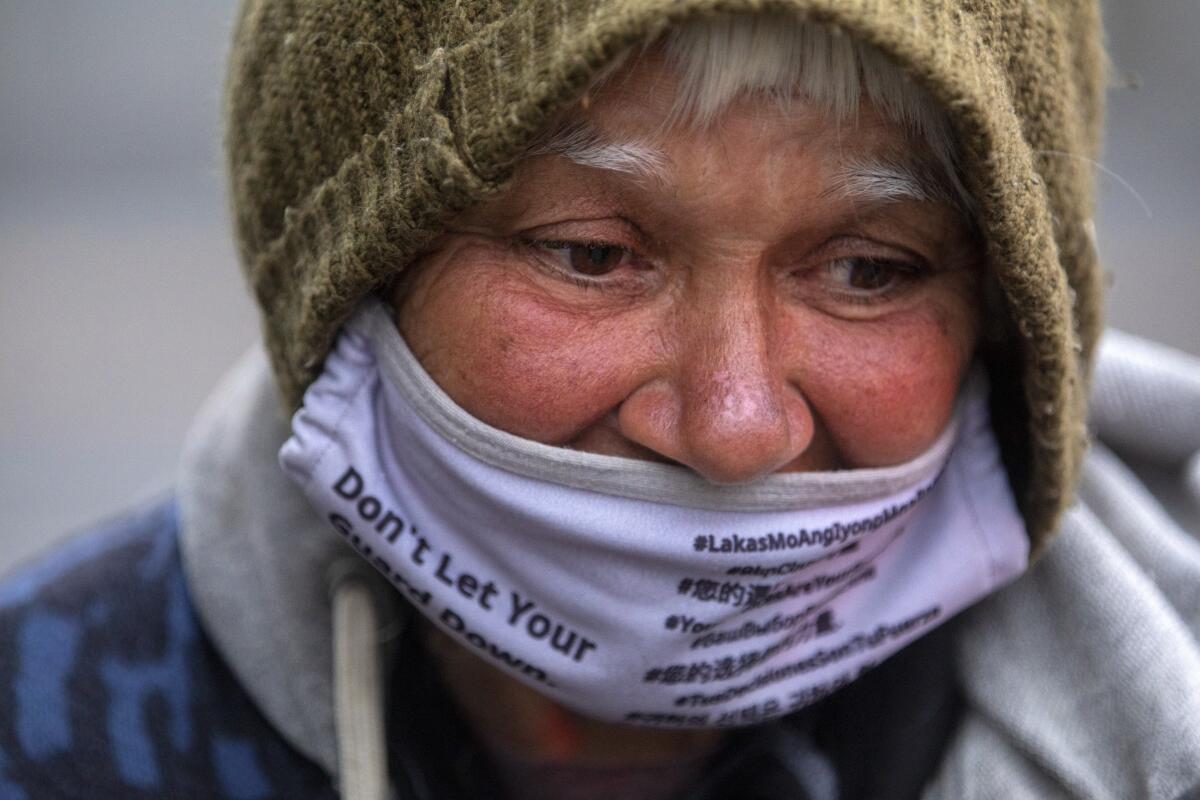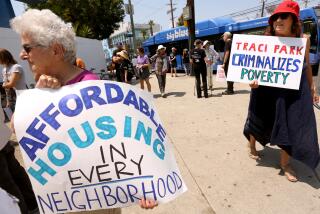Single homeless women in L.A. County suffer high levels of violence, new study finds

To help the more than 75,000 people experiencing homelessness in Los Angeles County, officials have long tailored their programs to the needs of subgroups, including veterans, families and the chronically homeless.
Another group eventually joined that list: single homeless women, whose numbers have been increasing and who, at 14,403, are nearly 20% of the county’s homeless population.
Last week, researchers released the first countywide study of single homeless women, which found that they suffered extraordinarily high levels of violence, before and after becoming homeless.
The 98-page report by the nonprofits Urban Institute and Hub for Urban Initiatives found that 60% of the women had something stolen from them while homeless. More than 40% said they were repeatedly harassed or threatened, 38% witnessed an attack, 35% were attacked themselves, and more than 20% said they were forced to take part in unwanted sexual activity.
The women often had long histories of trauma and victimization, with nearly half saying that domestic violence was a direct cause of their homelessness.
The report also found that the women were more likely than other homeless people to have fallen into homelessness more than once in their lifetimes.
“What I have done and what other women I know have done, in order to stay safe on these streets, [is] you have to sleep at a park where kids play with parents and stay up all night,” one homeless woman told the researchers.
Single homeless women make up nearly 70% of the women experiencing homelessness on any given night in the county, according to the report.
About 70% of the 600 women included in the report were unsheltered, with 40% of the unsheltered sleeping on the street, 23% sleeping in vehicles and about 4% on beaches or in riverbeds.
The remaining 30% were staying in shelters, including hotels, motels, “tiny villages” and emergency shelters.
About 34% of the women identified as Latina while 32% identified as Black, a group that is overrepresented in the homeless population in a county that is 49% Latino and 9% Black. Compared with other groups, Black women were more likely to be concerned about the way they would be treated by staff at shelters.
The Los Angeles Homeless Services Authority reported 22,320 women experiencing homelessness in 2023, including women with partners or family households — a 6% increase from the previous year.
Since 2015, the number of homeless women in L.A. County has jumped by 63% from 13,643 to 22,320. Overall, homelessness in the county increased by 70% during the same period.
Many women said they preferred private units over shared living spaces and pointed to thefts and safety concerns as reasons they stayed away from emergency shelters. Many also complained about lack of access to hygiene facilities, such as clean restrooms and laundromats.
The report was funded by the Los Angeles County Homeless Initiative and the Downtown Women’s Center, a nonprofit that provides services to unhoused women.
Samantha Batko, co-author of the report, said it provides a wealth of information about one of the county’s most vulnerable groups.
“This is a population that’s increasing in size, it’s a population that is highly vulnerable and is likely to experience assault and have poor health,” said Batko, who is principal research associate at the Urban Institute’s Metropolitan Housing and Communities Policy Center. “Oftentimes, unsheltered women were found to be in even worse conditions and have worse outcomes — worse than men who were in unsheltered situations.”
Los Angeles County Supervisor Hilda Solis, who co-authored a motion to make single homeless women an official subgroup, said the countywide survey was long overdue.
“Homelessness does not discriminate based on gender, but its impact on women is distinct, often ignored and often compounded by additional challenges,” she said. “To truly address the homelessness crisis in our county, we need to recognize and prioritize the needs of homeless women.”
She added: “This report confirms what we already know: If we provide women with access to safe housing, hygiene, healthcare and opportunities for economic stability, we can break the cycle of poverty and pave the way for a more equitable future.”
The report builds off the work of the Downtown Women’s Center, which has been conducting similar surveys every three years since 2001. The surveys were intended to identify gaps in services for single women — officially identified as unaccompanied women — on Skid Row. In 2019, the scope expanded to include women experiencing homelessness across the city of Los Angeles.
The Urban Institute researchers provided a list of recommendations for policymakers, including continuing to expand data collection and improving safety and accessibility to shelters and housing, as well as access to hygiene facilities and supplies.
More to Read
Sign up for Essential California
The most important California stories and recommendations in your inbox every morning.
You may occasionally receive promotional content from the Los Angeles Times.











